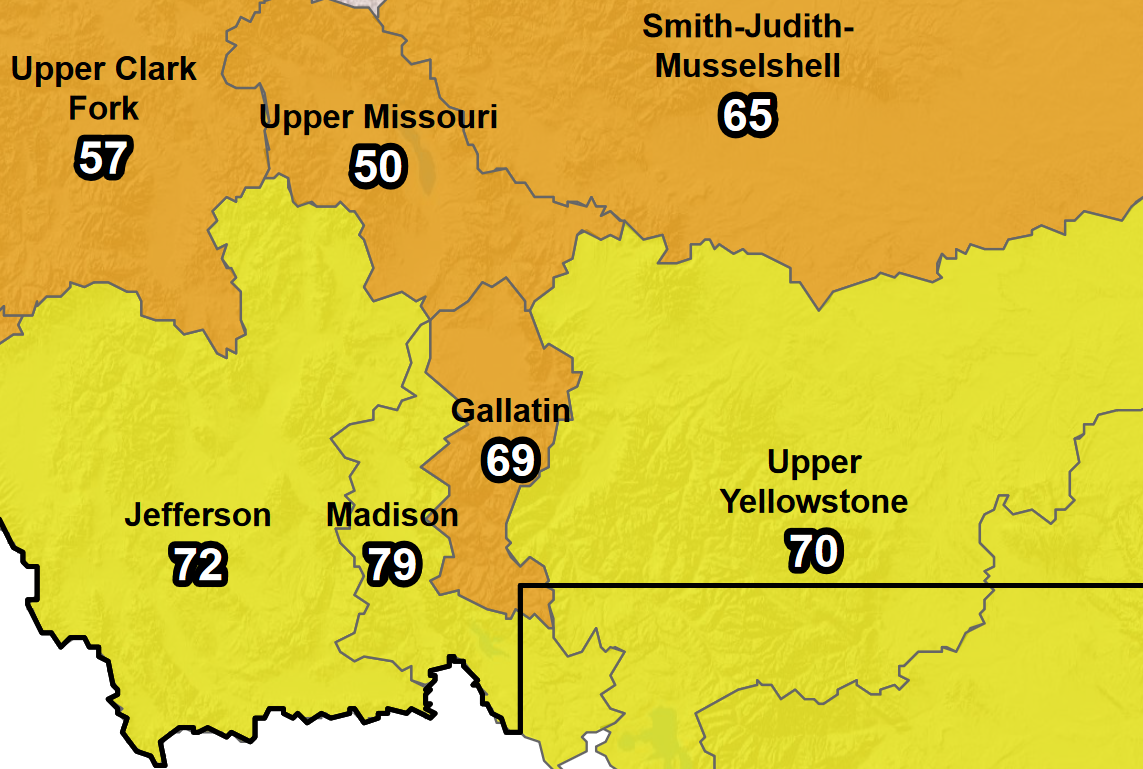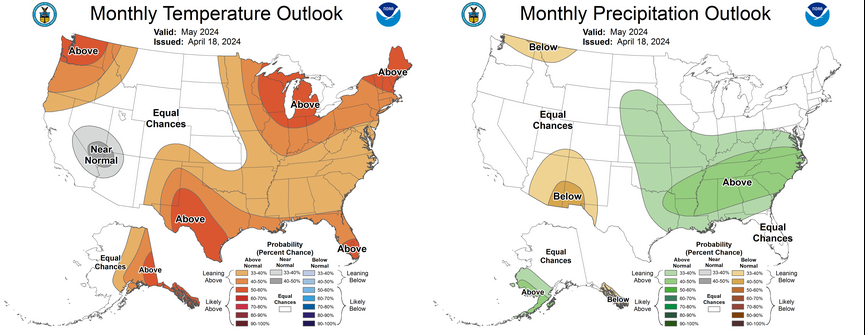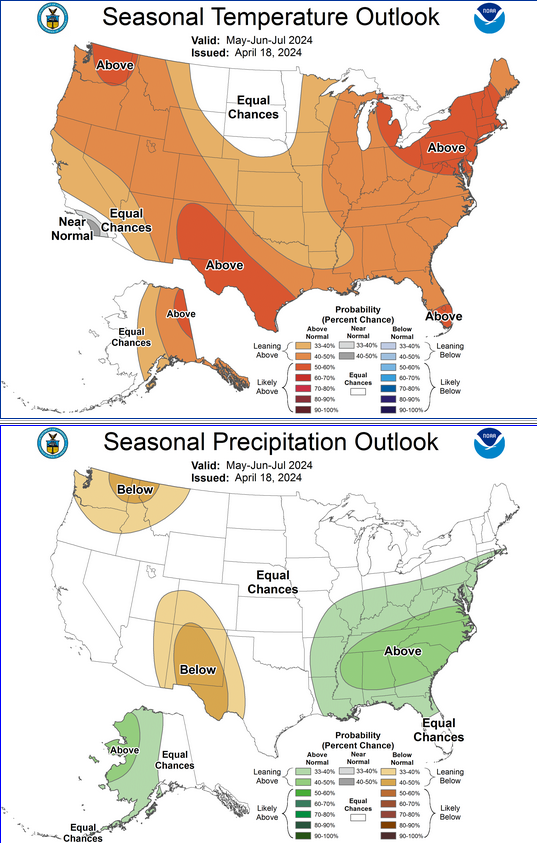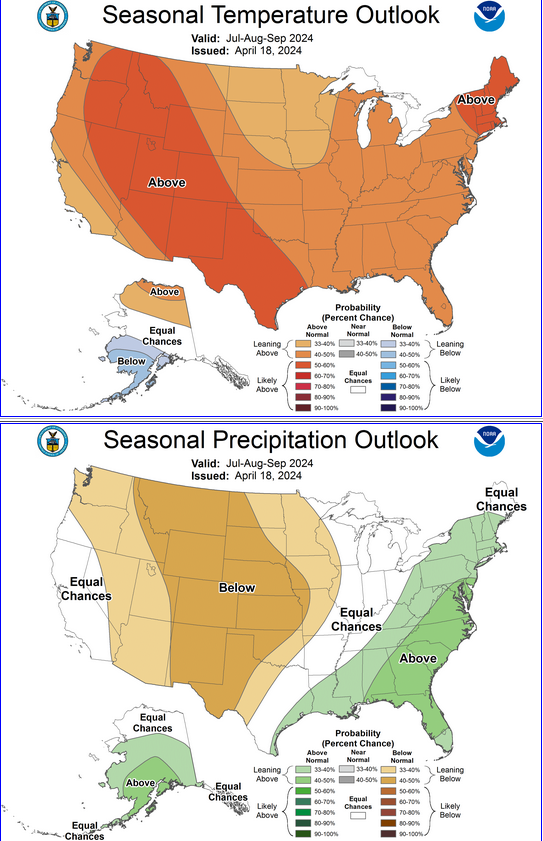Snowpack Update and Summer Streamflow and Fishing Forecast for April 19, 2024
Posted on April 19th, 2024 in Season Forecasts, Weather & Water Conditions
Winter and early spring 2023-2024 has been warm and dry in Yellowstone Country, just like it has just about everywhere except California through Colorado. For a while we were flirting with record-low snowpack and the potential for a very short fishing season. After strong improvement from mid-January through March, April has seen a decline in snowpack and we’re looking at tough conditions again in late summer and early fall.
Because of anticipated low and warm streamflows and a forecast for a hot, dry summer, we encourage anglers to visit sometime between June 20 and July 20 if you’re looking for consistent summer-type fishing with dry-dropper combos, fast, cold flows, etc. July 20 through August 20 are likely to see very low water and widespread 2:00PM mandatory closures. August 20 through September will see better conditions, but low, clear water will still make for difficult fishing on sunny days. Only in October and November will we be sure of aggressive fish again.
With Yellowstone Park opening portions of the Gardner and Madison Rivers to year-round fishing beginning November 1, this may be a year to skip August and come in early November instead, especially if you’re an angler who likes to walk-wade and doesn’t mind cold weather fishing.
Anglers who visit in late summer and early fall are strongly advised to be flexible as far as destinations, tactics, trip start times (we will likely want to meet before dawn) and durations (morning half-days might be the way to go in August) and even target species. Anglers here on August 15 up for doing oddball stuff like throwing grasshoppers for carp might be a lot happier than anglers who insist on trying to fish the same flies on the mellowest stretches of Paradise Valley on the Yellowstone on the same date…
Note that the maps we used to include on these posts are no longer produced. Instead, find them here: NWCC Maps.
Winter Weather Summary and Current Snowpack
In Livingston we saw our heaviest snowstorm prior to late January in late October. That about sums things up. As of late January, we were sitting at roughly half to two-thirds of our normal snowpack, depending on location. Some areas of Montana were in even worse shape. We were expecting little to no spring melt and dire conditions possibly beginning as early as July 15.
Conditions improved in late winter due to slightly above normal precip in February and March. The areas in the far southern parts of Yellowstone Park and even into Wyoming south of the park (the Yellowstone’s extreme headwaters) in particular saw significant increases. Unfortunately, April has brought us back to warm and dry conditions. We saw near record highs in Livingston last weekend (high 70s) and an early start to the spring melt. Things have cooled off nicely since Tuesday and the high country has seen some snow, but the snowpack still took a substantial hit.
As of April 18, snowpack in our operations area ranged from 65% in the Smith-Judith-Musselshell Basin at the northern edge of our operations area to 85% of normal in the Madison watershed inside YNP. Our most important basins, the Yellowstone in YNP and in Montana, are at 76% and 70%, respectively. Since we consider anything less than 80% as of May 1 a real problem indicating a strong likelihood of 2:00 hoot owl closures and potentially full fishing closures, we are not happy with where we stand.
The only small bright spot is in our total precipitation numbers for the water year (which begins in the fall). Because we got a lot of rain at lower elevations through the fall and already this spring, our total precip numbers stand at 78% to 97% of normal, with our most important basins generally in the high 80s. Soil moisture is likewise good following a fairly wet year in 2023.
Here are the snowpack maps:


There’s not much help in the intermediate-range outlooks for the remainder of April. Above normal temperatures and precip are forecast. While rain at low elevations is good from now on, rain at high elevations for the next month is very bad as far as preserving snowpack. With long-range outlooks for May calling for even chances of near-normal, above-normal, and below-normal temperature and precipitation, it seems unlikely we’re going to see more big snowstorms or a drastically late beginning to the spring runoff, either of which would move the needle in the right direction.

Outlooks for Spring and Summer
Outlooks for spring and summer are likewise not what we want. The outlook for May through July (spring and early summer) has gotten worse since our last post at the beginning of April. Hopefully we keep near-normal precip at least, particularly in June and early July.

The late summer outlook is very similar to what we posted at the beginning of the month. We’re right in the bullseye for high likelihoods of hotter and drier than normal weather. This is almost never ideal, but on the heels of a low snowpack winter, it’s a recipe for tough conditions in late summer.

The only bright spot is that NOAA is now forecasting La Nina for next winter. The first year of a La Nina folloing a strong El Nino (which we had this past fall and winter, but which is not fading fast) is typically cold and wet to the northwest part of the continental USA, including Montana. We certainly hope so… In fact the hot/dry summer outlook is actually common for us in La Nina years. We like to see “LN” winters and springs, but “EN” summers as far as keeping temps in check and getting a little precip.
General Outlook for Summer Fishing
All of the above suggests we’re looking at a low snowpack running 70–80% of normal at the beginning of runoff, leading to an early end to runoff and low to extremely low water conditions for most of summer.
Because of this, we anticipate an early start to summer fishing on our most popular and important fisheries, with the best fishing running earlier to much earlier in the summer than normal. In general, we anticipate the peak 30-day period as far as consistency to be from June 20 through July 20. Larger rivers in Montana will slant slightly earlier than smaller wade-only streams in Yellowstone Park. The Yellowstone River should fish great the last ten days of June, while the Lamar is likely to be better July 10–20, for example.
Late summer (July 20 through August) will see low water and difficult fishing conditions. 2:00PM closures now seem almost certain on many or even most area rivers. These closures will almost certainly impact the entire Yellowstone River from the Yellowstone Park boundary to Laurel and may impact all area rivers. Complete closures are likely on the lower Madison River, the lower Gallatin River, the entire Jefferson River, and a few small odds and ends. Note that none of these complete closures impact places that fish well in late summer, anyway. The complete closures will not impact our operations. Yellowstone Park is likely to close all streams at 2:00. They do this to limit late-day pressure on small mountain creeks that generally remain cold enough, but cannot handle the full weight of angling pressure moving from the larger famous name waters after lunch.
The first half of August in particular is likely to be grim, especially on float fisheries outside YNP where water temps slant warmer than higher in the mountains. Water conditions and fishing quality from roughly August 20 through September will depend on prevailing weather conditions. Basically if we get some cooler, cloudy weather and/or early fall rains, the fishing will be good even with low water. If high sun and heat continue into mid-September or beyond, the fishing will be tough. That said, complete fishing closures are likely to be lifted no later than August 25 and should be limited to fisheries that are less important in late summer anyway, such as the Lower Madison. 2:00 closures will be lifted by August 25 elsewhere.
Detailed Predictions for Specific Watersheds
The following predictions cover the anticipated duration and magnitude of the spring melt as well as when we anticipate the most consistent fishing of the year to occur. Fisheries are discussed first via jurisdiction (Montana vs YNP), then according to their expected end to the spring melt.
Montana Fisheries
Paradise Valley Spring Creeks: No runoff, and the best fishing will occur from now through April and again in late June and July, as usual. Almost all late June and July dates are already fully booked.
Lower Madison River: Slightly higher water in late May and June, but no unfishable runoff. The best fishing will occur from May 20 through June 10. Water temperatures will rise over 70 degrees by June 25 absent a very cold June. 2:00 closures are certain in July and August. Full closures are likely.
Upper Madison River: Slightly higher water in late May and June, but there will not be an unfishable runoff period. Some days will be muddier in late May and early June, but it should never get so dirty that the San Juan Worm bite at least disappears. The best fishing will be from June 15 through early July. 2:00 closures are possible in late July and early August if we see extreme heat that begins in June instead of July. That said, this is the least likely float river with strong trout populations within 3hr of Livingston to see closures.
Gallatin and East Gallatin Rivers: There will be an unfishable runoff for 3 weeks or so starting around May 1 downstream of the Taylor Fork on the Gallatin. The best fishing will occur in late June and the first three weeks of July on the mainstem Gallatin. The best fishing will be in late June and early July on the East. 2:00 closures are almost certain on the mainstem downstream from Hwy 84 near Four Corners and on the entire East beginning in late July. Full closures are likely in these areas in late July and August.
Jefferson River: Unfishable runoff for three weeks starting in early to mid-May. 2:00 closures certain and full closures are likely beginning in late June or early July at the latest. It has honestly been a very long time since this river has seen more than a few days of good conditions between the end of runoff and the onset of blood-warm water. Unfortunately.
Boulder River: Unfishable runoff for three to four weeks starting around May 5–10, but there will be short windows of good fishing during this period whenever we see spells of cooler weather. The best fishing will occur during these spells of cool weather and for 2–3 weeks beginning in mid-June (for floating) and in July (for wading). The lower river will get too low to float sometime between July 4 and July 15, depending on the progress of the spring melt and early summer moisture. 2:00 closures are likely downstream of Natural Bridge Falls.
Yellowstone River: Unfishable runoff for 4–5 weeks beginning in the last few days of April (boo) to around May 10 (please, please, please). Unfortunately, given current forecasts we expect runoff to begin early. There will be fishable windows during the spring melt during any cold snaps, especially early and late in the runoff cycle. Runoff will peak much lower than normal at around 13,000 to 15,000 at Corwin Springs (20,000 is average). The best fishing will occur during these fishable windows as well as for a month beginning about a week after spring runoff recedes enough to make the river fishable. We anticipate the river will become fishable for good between June 10 and June 25. The Salmonfly hatch will commence between the 15th and 25th and is likely to be very good, albeit short in duration. The most consistent fishing of the year will take place between June 20 and July 20, with the absolute peak depending on June and July weather. Basically, the cooler June is and the cloudier July is, the better the fishing will be later in July. 2:00 closures are almost certain east of Livingston and likely everywhere from July 20 through August 20. Full closures are possible but unlikely except in the event of record heat and drought. Nonetheless, fishing in August and early September is going to be tough except in the roughest water and/or during cooler, cloudy weather. Overall, we anticipate the rough water near Gardiner will fish better than elsewhere in the mid-late season, particularly if you’re hoping to fish dry flies. The 20mi from Gardiner to Point of Rocks is likely the only stretch where we’ll be fishing dries regularly in August and the first half of September.
Stillwater River: Unfishable runoff for three to four weeks starting around May 10, but there will be short windows of good fishing during this period whenever we see spells of cooler weather. The best fishing will occur between June 20 and July 20 on the upper river and from July 4 into early August on the lower river provided water temps do not get too high (this will depend on summer temps and precip). If we see a hot summer, 2:00 closures are likely downstream of Nye beginning in late July and extending into late August. The lower river will hopefully remain high enough to float through August, but unless we see high summer and early fall precip, this is not a year when we’ll able to float the Stillwater after Labor Day. In fact, it’s possible flows will drop below the 450cfs magic number by August 15.
Creeks: Meadow streams like the upper Musselshell will be best in late June and too low/warm by mid-July. Mountain creeks will be best from July 4 until early August and will be trickles by late August.
Yellowstone Park Fisheries
All flowing water in YNP will see 2:00 closures in late July and August if we have a hot/dry summer. We do not anticipate any full closures in the park, even though all water downstream of geyser basins should really be closed from sometime in the first half of July until Labor Day.
Lakes in YNP: Almost all should be accessible and ice-free on the opener and will fish best for the first month (assuming they are open; Blacktail Ponds opens in early July and will probably already be too warm).
Firehole and Upper Madison Rivers: Tannin-stained “brown” water will be present prior to June 5, but these rivers will not see unfishable runoff. The best fishing will occur prior to June 10 on the Firehole and prior to June 20 on the Madison. Portions of the Firehole will see temp spikes over 70 degrees by June 15 and the Madison by June 25. They ought to close then, but probably won’t until the anticipated full 2:00 closure hits.
Gibbon River: No unfishable runoff downstream of Norris Geyser Basin. Above Norris, the water will probably be too high and cold prior to June 1, though never filthy muddy. The best fishing downstream of Norris will occur in the first ten days of June and trail off for the two weeks thereafter. It will exceed 70 degrees by June 25 and should be avoided. Above Norris, the best fishing will be from June 20 through July 20. The water will get very low but probably never over 70 degrees thereafter.
Yellowstone River (Grand Canyon): Will be high, difficult to wade, and murky but not unfishable for about two weeks at the beginning of the season. The fishing will be phenomenal with stonefly nymphs and streamers if you can handle the wading. Salmonflies will emerge after June 20 and be best June 25 through July 10. The best fishing will fade by late July, but this water will remain comparatively high and cold throughout the season and should get low enough to wade completely across in places (we won’t say where) by Labor Day, so this will probably be the best August and early September fishery in the region for those up for the travel.
Gardner River: The Lower Gardner will have clear days and muddy days from the opening of the season on May 25 until about June 10, then be nymphable but too high to fish on the surface for about a week. All of this fishing is for strong waders only. Thereafter it will get slightly easier to wade and fish with dry-dropper combos. Salmonflies will hatch from June 15–20 until July 20 depending on section. The area below Boiling River will get too warm by July 15 and stay that way until late September. The area between Osprey Falls and Boiling River will stay cool enough but probably be busy into early August, then get a lot harder though not impossible. The upper water near Indian Creek will drop and clear enough for your beginner fishing needs around June 20. It will fish best for the month thereafter.
Yellowstone River (Elsewhere): The upper river near and above Yellowstone Lake opens July 1 and will be best for the three weeks thereafter. Normally we suggest waiting here until July 15 to let the trout finish spawning, but because of the low water and warm winter, they ought to be done by July 1 this year. The Black Canyon might see a few fishable windows in early June, but will really drop in around June 15–20 and be best for the month thereafter. Flows will be low and the fish spookier than normal in August and early September, but this water is tight enough and deep enough it will still fish okay if you get away from the crowds near Gardiner and Hellroaring (the crowds can actually be awful near Gardiner now) and water temps stay under 70 degrees.
Lamar River System: Slough might be fishable with streamers around the opener before blowing out, if we have a cool spring. Realistically, all three major waters in this basin (Lamar, Soda Butte, Slough) will come in between June 15 and July 1 depending on when runoff begins and be best for the month thereafter. Late August and September will see very low water, very crowded conditions, and beat-up fish.
Creeks: Meadow streams will fall into shape around June 5 and be best from June 10 through July 10, except for those in the Gardner and Lamar systems which will come in between June 10 and June 20 and be best for the month after that. All will be trickles by early August. Rough mountain creeks will come in during late June and be best from around July 4 into early August, but will be trickles by late August.
Summary
We anticipate low to very low water and poor conditions in August, but late June and early July will see much better fishing than usual. In particular there will be many more clear opportunities (such as the Yellowstone in the Grand and Black Canyons) starting in June than usual. We suggest coming at least a couple weeks earlier in the season than usual, if you can, assuming you’re looking for your “usual” fishing conditions. We also suggest being adaptable in late July and August and fishing where water temps and flows are most conducive to good fishing, and using guide or shop-recommended tactics. If you insist on fishing hoppers in the middle of Paradise Valley in August, you will probably be disappointed.
Our next full update will drop on April 30 or May 1, when the next long-range outlooks appear. This next update will be a kicker. If runoff has already started by the time we post it, we’ll KNOW we’re in for low, grim water conditions. If it’s cool and damp out, we could still push towards low but not abysmal conditions.